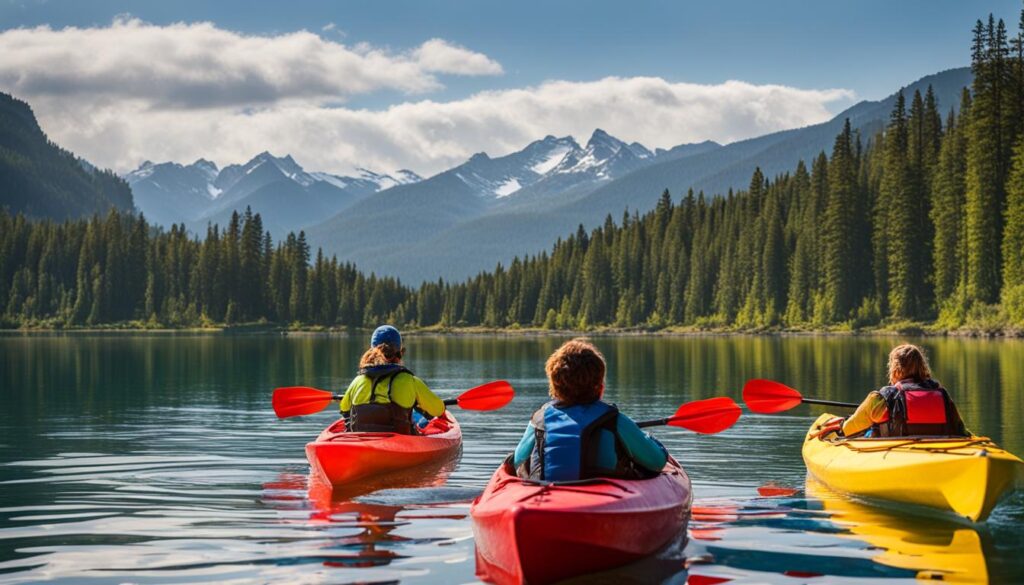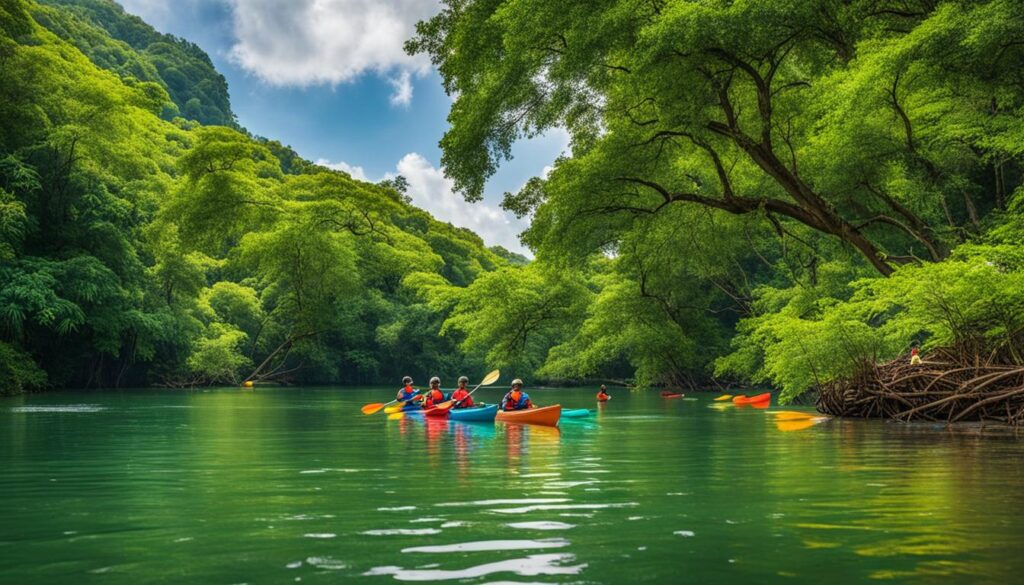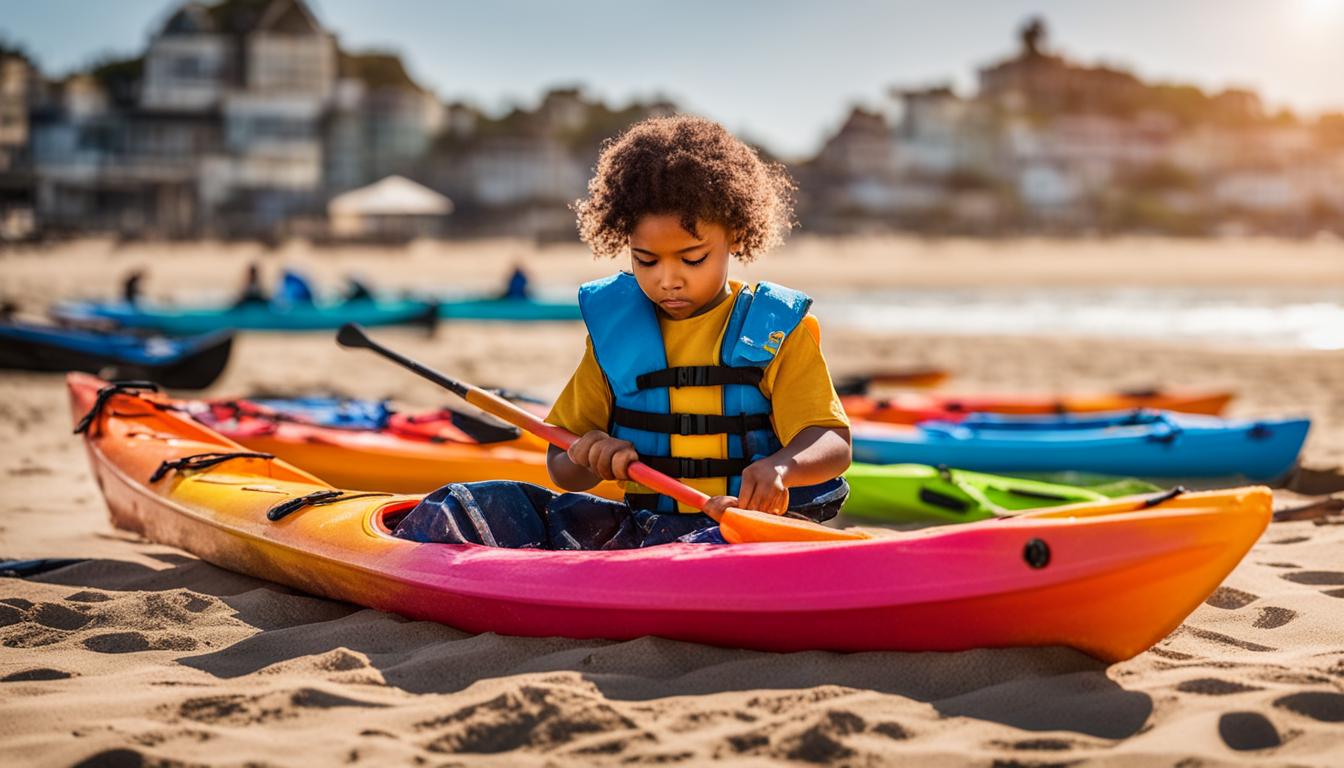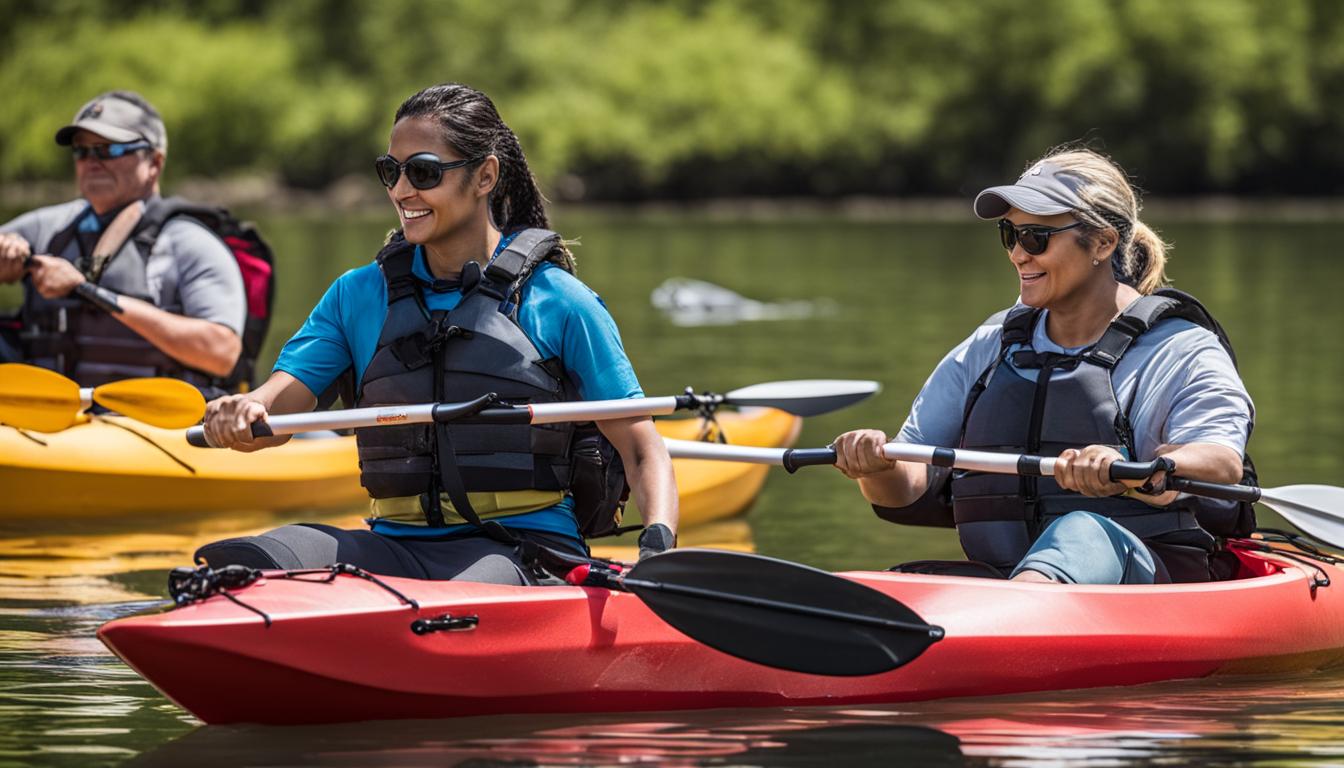Welcome to our article on kayaking school programs and educational field trips! If you’re looking for a unique and exciting way to engage students in hands-on learning, enhance their skills, and promote physical activity, then kayaking is the perfect choice. These programs integrate kayaking into school curriculums, offering a range of educational benefits while creating lasting memories for students. Let’s dive into the benefits, integration, field trips, and organization of school kayaking outings.
Kayaking school programs and educational field trips provide a combination of educational and recreational experiences. Students not only learn how to kayak and follow safety protocols but also develop teamwork, confidence, and a deeper appreciation for the environment. By immersing themselves in nature, students can foster a sense of stewardship and connect with the natural world like never before.
Key Takeaways:
- Kayaking school programs offer hands-on learning experiences.
- Integrating kayaking in school curriculums enhances physical education programs.
- Educational kayaking field trips provide opportunities for environmental learning.
- Organizing school kayaking outings requires careful planning and coordination.
- Kayaking promotes physical fitness, teamwork, and problem-solving skills.
Integrating Kayaking in School Curriculums
Integrating kayaking in school curriculums offers a range of benefits for students, enhancing their physical education programs and fostering a love for outdoor activities. By implementing kayaking as part of the curriculum, schools provide students with a unique recreational activity that promotes physical fitness, strength, and coordination.
Kayaking also offers opportunities for cross-curricular learning, allowing students to explore various subjects such as environmental science, geography, and teamwork. While out on the water, students can observe and learn about different ecosystems, aquatic life, and natural habitats, making their educational experience both hands-on and engaging.
Implementing kayaking in physical education classes helps students develop problem-solving skills as they navigate the water and enhances their ability to work effectively in teams. These skills extend beyond the kayaking experience and can be applied to other areas of their academic and personal lives. By integrating kayaking into school curriculums, schools provide students with a well-rounded and memorable educational experience that combines physical activity, outdoor exploration, and knowledge acquisition.
The Benefits of Integrating Kayaking in School Curriculums:
- Promotes physical fitness, strength, and coordination
- Offers opportunities for cross-curricular learning
- Enhances problem-solving and teamwork skills
- Provides a well-rounded and memorable educational experience
| Benefits | Examples of Cross-Curricular Learning |
|---|---|
| Promotes physical fitness, strength, and coordination | Students can learn about the biomechanics of kayaking and the science behind water sports. |
| Offers opportunities for cross-curricular learning | Students can explore topics such as environmental science, geography, and teamwork while out on the water. |
| Enhances problem-solving and teamwork skills | Students work together to navigate the water, solve challenges, and communicate effectively. |
| Provides a well-rounded and memorable educational experience | Students create lasting memories while acquiring knowledge, skills, and an appreciation for the environment. |
Incorporating kayaking into school curriculums enriches students’ education by providing them with a unique and immersive experience that combines physical activity and academic learning. By integrating kayaking into physical education classes and offering cross-curricular opportunities, schools can inspire students to become lifelong learners while fostering a love for outdoor exploration and wellness.

Educational Kayaking Field Trips for Students
Educational kayaking field trips offer students a unique opportunity to learn about the environment, wildlife, and ecosystems while engaging in a fun and adventurous activity. These field trips provide a hands-on approach to learning, allowing students to observe aquatic life, identify different species, and explore natural habitats. By immersing themselves in the natural world, students can develop a deeper understanding of the interconnectedness of ecosystems and the importance of conservation.
Planning kayaking field trips for schools involves careful consideration of safety protocols, equipment needs, and suitable locations that offer educational value. It is essential to work with experienced instructors who can provide proper instruction and guidance to ensure the safety and well-being of all participants. Additionally, choosing locations with diverse ecosystems and wildlife populations can enhance the learning experience and provide students with the opportunity to witness nature’s wonders firsthand.
Benefits of Educational Kayaking Field Trips
- Hands-on learning: Field trips allow students to apply the knowledge they have acquired in the classroom to real-world situations, enhancing their understanding of key concepts and fostering a deeper connection to the subject matter.
- Environmental awareness: By exploring natural habitats and witnessing the impact of human activities on the environment, students develop a sense of responsibility and stewardship for the natural world.
- Physical activity: Kayaking provides students with a fun and engaging form of exercise, promoting physical fitness and overall well-being.
- Teamwork and collaboration: Working together in kayaking groups fosters teamwork, communication, and problem-solving skills, as students navigate obstacles and overcome challenges.
- Memorable experiences: Educational kayaking field trips create lasting memories for students, instilling a sense of wonder and curiosity that can inspire lifelong learning.
Overall, educational kayaking field trips offer a unique and enriching experience for students, combining adventure, education, and environmental awareness. By immersing themselves in nature and learning through hands-on experiences, students develop a deeper understanding of the environment and the importance of conservation.
| Benefits of Educational Kayaking Field Trips | Description |
|---|---|
| Hands-on learning | Field trips allow students to apply classroom knowledge to real-world situations, enhancing understanding and connection to the subject matter. |
| Environmental awareness | Exploring natural habitats and witnessing environmental impact fosters responsibility and stewardship for the natural world. |
| Physical activity | Kayaking provides a fun and engaging form of exercise, promoting physical fitness and overall well-being. |
| Teamwork and collaboration | Kayaking in groups fosters teamwork, communication, and problem-solving skills as students navigate obstacles together. |
| Memorable experiences | Educational kayaking field trips create lasting memories, inspiring a sense of wonder and curiosity in students. |
It is important for schools to prioritize the safety and well-being of students during kayaking field trips. Implementing safety protocols such as wearing appropriate safety gear, providing thorough instruction and supervision, and ensuring proper equipment maintenance are essential. Schools should also consider the expertise and qualifications of the instructors or guides leading the field trips to ensure a safe and educational experience for all participants.
By organizing educational kayaking field trips, schools can provide students with an immersive learning experience that combines physical activity, environmental education, and teamwork. These experiences allow students to connect with nature, gain a deeper understanding of the natural world, and develop valuable skills that will benefit them throughout their lives.
Organizing School Kayaking Outings
Organizing school kayaking outings is an exciting opportunity to provide students with a unique and educational experience. Whether you are planning a day trip or a multi-day excursion, careful planning and coordination are essential to ensure the safety and enjoyment of all participants.
One important aspect to consider when organizing school kayaking outings is partnering with local kayaking outfitters or instructors. These professionals can provide guided trips and instruction, ensuring that students receive proper training and supervision. Additionally, they can help with logistics such as equipment rental and transportation, making the organization process smoother.
When selecting a location for your kayaking outing, it is important to choose a suitable area that offers both safety and educational value. Consider factors such as the difficulty level of the water, the presence of wildlife and natural landmarks, and accessibility for all participants. By choosing a location that offers educational opportunities, students can learn about the local ecosystem, wildlife, and environmental conservation.
During the outing, it is crucial to prioritize safety. Ensure that all students receive proper instructions on paddling techniques, water safety protocols, and emergency procedures. Provide them with appropriate safety gear, including life jackets, and establish clear guidelines for behavior and group management. By prioritizing safety, you can create a positive and secure environment for students to enjoy their kayaking experience.

Conclusion
Kayaking is a fantastic school activity that offers numerous educational benefits for students. By participating in kayaking school programs and field trips, students have the opportunity to not only enhance their physical fitness and teamwork skills but also gain a deeper understanding of the environment and develop an appreciation for nature.
Integrating kayaking into school curriculums and organizing kayaking outings can create unique and memorable experiences that promote learning and personal growth. Through kayaking, students can connect with the outdoors, learn about wildlife and ecosystems, and acquire lifelong skills and hobbies.
So, if you’re looking for an exciting and educational activity for your school, consider adding kayaking to your program. The benefits are invaluable, and the memories created will last a lifetime. Kayaking truly offers a remarkable way for students to engage with the natural world, expand their knowledge, and develop essential life skills.
FAQ
Are kayaking school programs and educational field trips safe for students?
Yes, safety is a top priority for kayaking school programs and educational field trips. These programs have safety protocols in place, provide necessary equipment and instruction, and ensure that students are supervised by qualified instructors.
How does kayaking benefit students?
Kayaking offers a range of benefits for students. It promotes teamwork, builds confidence, connects students with nature, and fosters an appreciation for the environment. It also enhances physical fitness, coordination, endurance, and problem-solving skills.
What educational value do kayaking field trips provide?
Kayaking field trips allow students to learn about the environment, wildlife, and ecosystems in a hands-on way. They can observe aquatic life, identify different species, and explore natural habitats, developing a deeper understanding of the natural world and fostering stewardship for the environment.
How can schools organize kayaking outings?
Schools can partner with local kayaking outfitters or instructors to provide guided trips and instruction. Factors such as group size, participant age and skill level, weather conditions, and equipment needs need to be considered for a safe and enjoyable experience.
What are the benefits of integrating kayaking into school curriculums?
Integrating kayaking into school curriculums enhances physical education programs and provides students with a unique recreational activity. It offers an alternative to traditional sports, promotes physical fitness and outdoor skills, and allows for cross-curricular learning in topics such as environmental science, geography, and teamwork.





